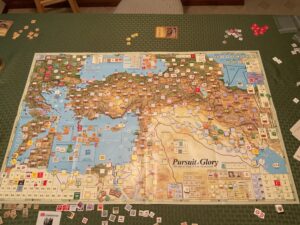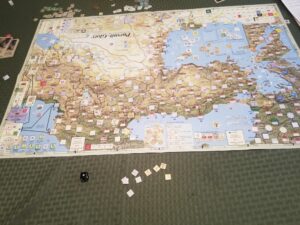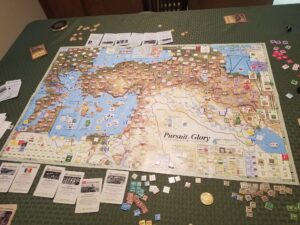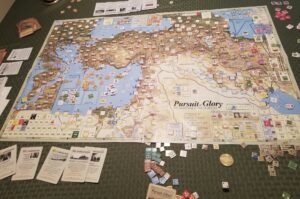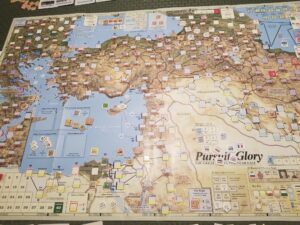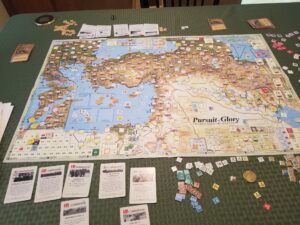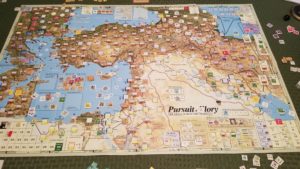Back after another long hiatus involving travel and toil.
Drove over to Tim’s for another grind through Pursuit of Glory. Grind? Yes. As posted before, the game is a brain twister, but very enjoyable.
As always, too much fun chatter and perhaps not enough serious gaming. But, we were able to get into 1916, with Tim’s Allies having a decided advantage.
We agreed this session was different than the others. Fewer casualties, with more activity in Sinai/Palestine/Syria than usual, with less in Persia and “The Back of Beyond”.
Here’s a breakdown of action by region.
Sinai/Palestine/Syria: The Turks actually made it across the Suez Canal, but were quickly forced back by British/ANZAC/Indian units. Tim continued placing pressure on the Turks, taking Jerusalem and Damascus. He correctly pointed out that I should have built a corps in Damascus. Corps building is a real challenge for the Ottomans. They do not receive corps as reinforcements, just divisions. So, corps (which have increased fighting and staying power) must be assembled from two (for reduced corps) or three (full strength) divisions. This means using operations points move them to a common location and/or to assemble them.
Mesopotamia: The Allies steadily advanced from Basra towards Baghdad. Here, I was able to assemble two corps, which stopped the Allies just short of the city. The Central Powers had difficulties generating tribal resistance, which can be very effective stopping/delaying an Allied advance.
Caucasus: Not the usual bloodbath. I attribute this to the few mandated offensives for either side, as well as no dreaded “Enver” offensives that can be devastating to the Turks, especially in the Winter when combat odds are very unfavorable for the attacker.
The Balkans: This theater developed rather late in the game with first Romania (Allies) and then Bulgaria (Central Powers) entering the war. The Serbs (Allies) were in an unfavorable position when the game ended.
Other: Tim opened up the possibility of a landing in Gallipoli, which achieved its purpose of drawing valuable Ottoman units West, instead of East – where most of the action took place. He did land at Salonika, but had not advanced by game’s end.
Tim did an excellent job of maintaining pressure on the Turks, forcing me to spend Operation Points on reacting as opposed to proactive uses such as corps building and strategic movement. The latter is very important for the Ottomans, given the distances to be traveled and poor infrastructure. Their “interior lines” are more of a handicap than advantage.
At game’s end, Tim had a decided advantage, with the Ottomans just five victory points from defeat.
Here’s a quick pic of the board at session’s end.
